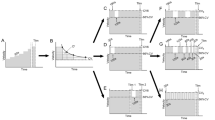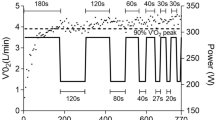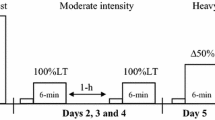Abstract
Purpose
Although time spent at \(\dot{V}\)O2max (t@\(\dot{V}\)O2max) has been suggested as an optimal stimulus for the promotion of greater \(\dot{V}\)O2max improvements, scientific findings supporting this notion are surprisingly still lacking. To investigate this, the present study described t@\(\dot{V}\)O2max in two different severe-intensity interval training regimens and compared its effects on aerobic indexes after a 4-week intervention.
Methods
Twenty-one recreational cyclists performed an incremental exercise test and six time-to-exhaustion tests on four different days to determine \(\dot{V}\)O2max, lactate threshold (LT), critical power (CP) and the highest intensity (I HIGH) and lowest exercise duration (T LOW) at which \(\dot{V}\)O2max was attained. Subjects were assigned to the lower (LO, n = 11, 4 × 5 min at 105 % CP, 1 min recovery) or the upper severe-intensity training groups (UP, n = 10, 8 × 60 % T LOW at 100 % I HIGH, 1:2 work:recovery ratio). t@\(\dot{V}\)O2max was measured during the first and last training sessions.
Results
A significantly higher t@\(\dot{V}\)O2max was elicited in the UP during training sessions in comparison with the LO group (P < 0.05), and superior improvements were observed in \(\dot{V}\)O2max (change in measure ±95 % confidence interval) (6.3 ± 1.9 vs. 3.3 ± 1.8 %, P = 0.034 for interaction terms) and LT (54.8 ± 11.8 vs. 27.9 ± 11.3 %, P = 0.023 for interaction terms). The other aerobic indexes were similarly improved between the groups.
Conclusion
The present results demonstrated that UP training produced superior gains in \(\dot{V}\)O2max and LT in comparison with LO training, which may be associated with the higher t@\(\dot{V}\)O2max.


Similar content being viewed by others
Abbreviations
- CP:
-
Critical power
- HIT:
-
High-intensity interval training
- I HIGH :
-
The highest constant intensity at which \(\dot{V}\)O2max is attained
- LO:
-
Lower severe-intensity exercise domain training group
- LT:
-
Lactate threshold
- MAP:
-
Maximal aerobic power
- SEE:
-
Standard error of estimate
- t@\(\dot{V}\)O2max:
-
Time spent at maximum oxygen uptake
- T LIM :
-
Time to exhaustion
- T LOW :
-
The lowest exercise duration at which \(\dot{V}\)O2max is attained
- UP:
-
Upper severe-intensity exercise domain training group
- \(\dot{V}\)O2 :
-
Oxygen uptake
- \(\dot{V}\)O2max:
-
Maximum oxygen uptake
- \(\dot{V}\)O2peak:
-
Highest average \(\dot{V}\)O2 over a 15-s period
- W′:
-
Work capacity above critical power
References
Achten J, Jeukendrup AE (2004) Relation between plasma lactate concentration and fat oxidation rates over a wide range of exercise intensities. Int J Sports Med 25(1):32–37. doi:10.1055/s-2003-45231
Bacon AP, Carter RE, Ogle EA, Joyner MJ (2013) VO2max trainability and high intensity interval training in humans: a meta-analysis. PLoS One 8(9):e73182. doi:10.1371/journal.pone.0073182
Bassett DR Jr, Howley ET (2000) Limiting factors for maximum oxygen uptake and determinants of endurance performance. Med Sci Sports Exerc 32(1):70–84
Bergstrom HC, Housh TJ, Zuniga JM, Traylor DA, Lewis RW Jr, Camic CL, Schmidt RJ, Johnson GO (2014) Differences among estimates of critical power and anaerobic work capacity derived from five mathematical models and the three-minute all-out test. J Strength Cond Res 28(3):592–600. doi:10.1519/JSC.0b013e31829b576d
Billat LV (2001) Interval training for performance: a scientific and empirical practice. Special recommendations for middle- and long-distance running. Part I: aerobic interval training. Sports Med 31(1):13–31
Bonne TC, Doucende G, Fluck D, Jacobs RA, Nordsborg NB, Robach P, Walther G, Lundby C (2014) Phlebotomy eliminates the maximal cardiac output response to six weeks of exercise training. Am J Physiol Regul Integr Comp Physiol 306(10):R752–R760. doi:10.1152/ajpregu.00028.2014
Buchheit M, Laursen PB (2013) High-intensity interval training, solutions to the programming puzzle: part I: cardiopulmonary emphasis. Sports Med 43(5):313–338. doi:10.1007/s40279-013-0029-x
Burnley M, Jones AM (2007) Oxygen uptake kinetics as a determinant of sports performance. Eur J Sport Sci 7(2):63–79. doi:10.1080/17461390701456148
Caputo F, Denadai BS (2008) The highest intensity and the shortest duration permitting attainment of maximal oxygen uptake during cycling: effects of different methods and aerobic fitness level. Eur J Appl Physiol 103(1):47–57. doi:10.1007/s00421-008-0670-5
Carter H, Pringle JS, Jones AM, Doust JH (2002) Oxygen uptake kinetics during treadmill running across exercise intensity domains. Eur J Appl Physiol 86(4):347–354
Daussin FN, Ponsot E, Dufour SP, Lonsdorfer-Wolf E, Doutreleau S, Geny B, Piquard F, Richard R (2007) Improvement of VO2max by cardiac output and oxygen extraction adaptation during intermittent versus continuous endurance training. Eur J Appl Physiol 101(3):377–383. doi:10.1007/s00421-007-0499-3
de Aguiar RA, Turnes T, de Oliveira Cruz RS, Caputo F (2013) Fast-start strategy increases the time spent above 95 % VO2max during severe-intensity intermittent running exercise. Eur J Appl Physiol 113(4):941–949. doi:10.1007/s00421-012-2508-4
De Pauw K, Roelands B, Cheung SS, de Geus B, Rietjens G, Meeusen R (2013) Guidelines to classify subject groups in sport-science research. Int J Sports Physiol Perform 8(2):111–122
Denadai BS, Ortiz MJ, Greco CC, de Mello MT (2006) Interval training at 95 % and 100 % of the velocity at VO2max: effects on aerobic physiological indexes and running performance. Appl Physiol Nutr Metab 31(6):737–743. doi:10.1139/h06-080
Gaesser GA, Wilson LA (1988) Effects of continuous and interval training on the parameters of the power-endurance time relationship for high-intensity exercise. Int J Sports Med 9(6):417–421. doi:10.1055/s-2007-1025043
Gaesser GA, Carnevale TJ, Garfinkel A, Walter DO, Womack CJ (1995) Estimation of critical power with nonlinear and linear models. Med Sci Sports Exerc 27(10):1430–1438
Hill DW, Poole DC, Smith JC (2002) The relationship between power and the time to achieve VO2max. Med Sci Sports Exerc 34(4):709–714
Jacobs RA, Rasmussen P, Siebenmann C, Diaz V, Gassmann M, Pesta D, Gnaiger E, Nordsborg NB, Robach P, Lundby C (2011) Determinants of time trial performance and maximal incremental exercise in highly trained endurance athletes. J Appl Physiol 111(5):1422–1430. doi:10.1152/japplphysiol.00625.2011
Jenkins DG, Quigley BM (1992) Endurance training enhances critical power. Med Sci Sports Exerc 24(11):1283–1289
Jones AM, Wilkerson DP, DiMenna F, Fulford J, Poole DC (2008) Muscle metabolic responses to exercise above and below the “critical power” assessed using 31P-MRS. Am J Physiol Regul Integr Comp Physiol 294(2):R585–R593. doi:10.1152/ajpregu.00731.2007
Jones AM, Vanhatalo A, Burnley M, Morton RH, Poole DC (2010) Critical power: implications for determination of VO2max and exercise tolerance. Med Sci Sports Exerc 42(10):1876–1890. doi:10.1249/MSS.0b013e3181d9cf7f
Knechtle B, Muller G, Willmann F, Kotteck K, Eser P, Knecht H (2004) Fat oxidation in men and women endurance athletes in running and cycling. Int J Sports Med 25(1):38–44. doi:10.1055/s-2003-45232
Kuipers H, Verstappen FT, Keizer HA, Geurten P, van Kranenburg G (1985) Variability of aerobic performance in the laboratory and its physiologic correlates. Int J Sports Med 6(4):197–201. doi:10.1055/s-2008-1025839
Laursen PB, Jenkins DG (2002) The scientific basis for high-intensity interval training: optimising training programmes and maximising performance in highly trained endurance athletes. Sports Med 32(1):53–73
Levine BD, Lane LD, Buckey JC, Friedman DB, Blomqvist CG (1991) Left ventricular pressure-volume and Frank-Starling relations in endurance athletes. Implications for orthostatic tolerance and exercise performance. Circulation 84(3):1016–1023
Lundby C, Robach P (2015) Performance enhancement: what are the physiological limits? Physiology 30(4):282–292. doi:10.1152/physiol.00052.2014
Midgley AW, Mc Naughton LR (2006) Time at or near VO2max during continuous and intermittent running. A review with special reference to considerations for the optimisation of training protocols to elicit the longest time at or near VO2max. J Sports Med Phys Fit 46(1):1–14
Midgley AW, McNaughton LR, Wilkinson M (2006) Is there an optimal training intensity for enhancing the maximal oxygen uptake of distance runners?: empirical research findings, current opinions, physiological rationale and practical recommendations. Sports Med 36(2):117–132
Midgley AW, McNaughton LR, Carroll S (2007a) Reproducibility of time at or near VO2max during intermittent treadmill running. Int J Sports Med 28(1):40–47. doi:10.1055/s-2006-923856
Midgley AW, McNaughton LR, Jones AM (2007b) Training to enhance the physiological determinants of long-distance running performance: can valid recommendations be given to runners and coaches based on current scientific knowledge? Sports Med 37(10):857–880
Moritani T, Nagata A, deVries HA, Muro M (1981) Critical power as a measure of physical work capacity and anaerobic threshold. Ergonomics 24(5):339–350. doi:10.1080/00140138108924856
Morton RH (1996) A 3-parameter critical power model. Ergonomics 39(4):611–619. doi:10.1080/00140139608964484
Moseley L, Jeukendrup AE (2001) The reliability of cycling efficiency. Med Sci Sports Exerc 33(4):621–627
Noakes TD, Myburgh KH, Schall R (1990) Peak treadmill running velocity during the VO2max test predicts running performance. J Sports Sci 8(1):35–45. doi:10.1080/02640419008732129
Poole DC, Ward SA, Gardner GW, Whipp BJ (1988) Metabolic and respiratory profile of the upper limit for prolonged exercise in man. Ergonomics 31(9):1265–1279. doi:10.1080/00140138808966766
Poole DC, Ward SA, Whipp BJ (1990) The effects of training on the metabolic and respiratory profile of high-intensity cycle ergometer exercise. Eur J Appl Physiol Occup Physiol 59(6):421–429
Robergs RA, Dwyer D, Astorino T (2010) Recommendations for improved data processing from expired gas analysis indirect calorimetry. Sports Med 40(2):95–111. doi:10.2165/11319670-000000000-00000
Ronnestad BR, Hansen J, Vegge G, Tonnessen E, Slettalokken G (2014) Short intervals induce superior training adaptations compared with long intervals in cyclists—an effort-matched approach. Scand J Med Sci Sports. doi:10.1111/sms.12165
Scharhag-Rosenberger F, Meyer T, Gassler N, Faude O, Kindermann W (2010) Exercise at given percentages of VO2max: heterogeneous metabolic responses between individuals. J Sci Med Sport 13(1):74–79. doi:10.1016/j.jsams.2008.12.626
Turnes T, Salvador AF, Lisboa FD, de Aguiar RA, Cruz RS, Caputo F (2014) A fast-start pacing strategy speeds pulmonary oxygen uptake kinetics and improves supramaximal running performance. PLoS One 9(10):e111621. doi:10.1371/journal.pone.0111621
Vanhatalo A, Doust JH, Burnley M (2008) A 3-min all-out cycling test is sensitive to a change in critical power. Med Sci Sports Exerc 40(9):1693–1699. doi:10.1249/MSS.0b013e318177871a
Wenger HA, Bell GJ (1986) The interactions of intensity, frequency and duration of exercise training in altering cardiorespiratory fitness. Sports Med 3(5):346–356
Acknowledgments
We would like to express our gratitude to all colleagues who contributed and to the subjects in this study. This study was supported by the National Council of Scientific and Technological Development (CNPq) and Santa Catarina State Research Foundation (FAPESC).
Author information
Authors and Affiliations
Corresponding author
Ethics declarations
Conflict of interest
The authors declare that they have no conflict of interest. The results of the current study do not constitute endorsement of the product by the authors or the journal.
Additional information
Communicated by Susan Hopkins.
Rights and permissions
About this article
Cite this article
Turnes, T., de Aguiar, R.A., Cruz, R.S. et al. Interval training in the boundaries of severe domain: effects on aerobic parameters. Eur J Appl Physiol 116, 161–169 (2016). https://doi.org/10.1007/s00421-015-3263-0
Received:
Accepted:
Published:
Issue Date:
DOI: https://doi.org/10.1007/s00421-015-3263-0




